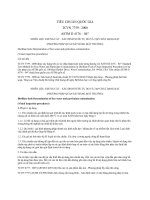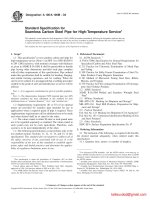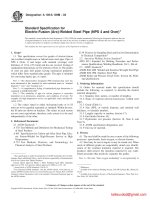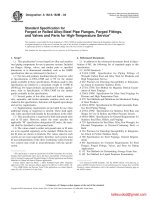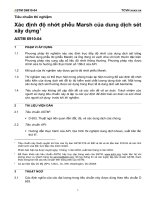Astm f 677 04
Bạn đang xem bản rút gọn của tài liệu. Xem và tải ngay bản đầy đủ của tài liệu tại đây (34.21 KB, 4 trang )
An American National Standard
Designation: F 677 – 04
Standard Test Method for
Fluid and Grease Resistance of Thermoset Encapsulating
Compounds Used in Electronic and Microelectronic
Applications1
This standard is issued under the fixed designation F 677; the number immediately following the designation indicates the year of
original adoption or, in the case of revision, the year of last revision. A number in parentheses indicates the year of last reapproval. A
superscript epsilon (e) indicates an editorial change since the last revision or reapproval.
3.1.1 For the definitions of terms used in this standard, refer
to Terminology D 1711.
1. Scope
1.1 This test method determines the resistance of encapsulating compounds to fluids or greases by measuring changes in
weight (Note 1) and volume under defined conditions of time
and temperature.
4. Summary of Test Method
4.1 Specimens of encapsulating compound are immersed in
fluids or greases for specified conditions of temperature and
time. The weight and volume of each specimen is measured
before and after immersion and percent change is reported.
4.2 The fluids and greases to be used as test media (8.3) are
not specified by the test method and shall be agreed to by the
parties to the test.
NOTE 1—To provide consistency with the usage in other ASTM test
methods concerned with determining the properties of plastic materials,
the terms “weight” and “weigh” are used in this test method although the
units of measurement are those of mass.
1.2 This standard does not purport to address all of the
safety concerns, if any, associated with its use. It is the
responsibility of the user of this standard to establish appropriate safety and health practices and determine the applicability of regulatory limitations prior to use. See 9.1.
1.3 The values stated in SI units are standard. The values in
parentheses are for information only.
5. Significance and Use
5.1 Fluids and greases in contact with encapsulating compounds may adversely modify the encapsulant properties with
resulting damage or loss of protection to components in
electronic applications.
5.2 This test method provides a means for measuring the
effect of fluids and greases on various encapsulants.
5.3 This test method is intended for use in research and
evaluation.
NOTE 2—There is no similar or equivalent IEC standard.
2. Referenced Documents
2.1 ASTM Standards: 2
D 1193 Specification for Reagent Water
D 1711 Terminology Relating to Electrical Insulation
D 5423 Specification for Forced-Convection Laboratory
Ovens for Evaluation of Electrical Insulation
D 6054 Practice for Conditioning Electrical Insulating Materials for Testing
6. Interferences
6.1 Test results obtained with molded or cast specimens of
filled encapsulating compounds will differ from those obtained
with cut or machined specimens (because of exposed fillers in
the latter).
6.2 Lack of complete contact between the test medium and
the surfaces of the specimen may seriously affect the results of
the test.
6.3 Some encapsulants may be affected by the reagents
specified for use in removing the test media from the specimens. Alternative reagents may be required, as agreed upon by
the parties to the test.
3. Terminology
3.1 Definitions:
1
This test method is under the jurisdiction of ASTM Committee D09 on
Electrical and Electronic Insulating Materials and is the direct responsibility of
Subcommittee D09.01 on Electrical Insulating Varnishes, Powders, and Encapsulating Compounds.
Current edition approved March 1, 2004. Published March 2004. Originally
approved in 1980. Discontinued 1991 and reinstated as F 677 – 95. Last previous
edition approved in 1999 as F 677 – 95(1999).
2
For referenced ASTM standards, visit the ASTM website, www.astm.org, or
contact ASTM Customer Service at For Annual Book of ASTM
Standards volume information, refer to the standard’s Document Summary page on
the ASTM website.
7. Apparatus
7.1 Analytical Balance, capable of determining weight to
the nearest 0.001 g.
7.2 Oven, forced-convection type meeting the requirements
of Specification D 5423, Type I.
Copyright © ASTM International, 100 Barr Harbor Drive, PO Box C700, West Conshohocken, PA 19428-2959, United States.
1
F 677 – 04
exposed surfaces of the specimens and insert coated specimens
into the dish to form a sandwich structure of alternating grease
and specimen layers.
13.3 Cover the assembled test specimens with a loose-fitting
glass cover and expose the assembled test specimens in an
oven at 71 6 3°C (160 6 5.4°F) for a total duration of 14 days.
13.4 Remove the specimens from the oven for measurement
and observation after cumulative exposure times of 24 6 2 h (1
day), 168 6 2 h (7 days), and 336 6 2 h (14 days).
13.4.1 Remove the assembled test specimens from the oven
and allow them to cool to room temperature for 30 to 60 min,
before conducting measurements and observations as follows:
13.4.1.1 Remove specimens one at a time from the test
medium, saving the test medium in the glass dish or other
convenient noncontaminating vessel. Remove (and save) highviscosity fluids and greases from the specimen with a spatula.
Wipe with a lint-free filter paper before dipping the specimen
in acetone.
13.4.1.2 Dip each specimen quickly into acetone to remove
the remaining test medium and blot with filter paper (see 6.3).
13.4.1.3 Within 1 min after removing the specimen from the
test medium, weigh the specimen in air to the nearest 0.001 g
and record the value as W3.
13.4.1.4 Immerse each specimen in distilled water, and
within 1 min after the determination in air, weigh each
specimen while immersed, to the nearest 0.001 g; record the
value as W 4.
13.4.1.5 Dip each specimen in isopropyl alcohol to remove
the water after the weight in water (W4) has been determined.
Then blot the specimen with filter paper.
13.4.1.6 Visually examine each set of specimens and the
associated test media from a single glass dish. Record the
condition of the specimens and media. Note characteristics
such as color change, cracking, swelling, shrinking, surface
change, tackiness, etc.
13.4.1.7 When the test is to be continued, replace the
specimen in the glass dish, and cover the specimen with the
same test medium saved in 13.4.1.1. Reform the sandwich
structure described in 13.2. If there is insufficient test medium
to cover the specimens, add additional medium.
7.3 Glass Dishes, of sufficient diameter for specimens to be
exposed horizontally, and of sufficient height for specimens to
be completely covered by the test medium. A loose-fitting glass
cover shall be provided for each dish (see 13.3).
8. Reagents and Materials
8.1 Use the following materials:
8.1.1 Acetone.
8.1.2 Distilled Water—Type III Reagent Water as defined in
Specification D 1193.
8.1.3 Isopropyl Alcohol.
8.2 Filter Paper, medium retention and medium filtering
speed, free of lint or foreign material.
8.3 Test Media—agreed-upon fluids or greases.
9. Safety Precautions
9.1 Some encapsulating compounds are known to contain
toxic components, and special precautions are required in
handling. Follow manufacturer’s precautionary instructions
and sound laboratory safety practices.
10. Sampling
10.1 Because of the diverse nature of the encapsulating
compounds, and the various forms and packages of resin,
hardeners, catalysts, etc. commercially available, no standard
methods of sampling have been established. Select an adequate
amount of material, representative of each ingredient from
each lot to permit preparation of specimens as agreed upon by
the parties to the test.
11. Test Specimen
11.1 Prepare three specimens of each encapsulating compound to be tested, in accordance with generally accepted
practices.
11.1.1 Each specimen shall be a disk 51 6 2.5 mm (2 6 0.1
in.) diameter and 3 6 0.30 mm (0.125 6 0.01 in.) in thickness
(see 6.1). Surface finish of machined specimens shall be 64
maximum.
12. Conditioning
12.1 Unless otherwise specified, condition all specimens for
40 h at Standard Laboratory Atmosphere in accordance with
Procedure A of Practice D 6054.
14. Calculation
13. Procedure
13.1 Weigh each specimen in air to the nearest 0.001 g and
record value as W1. Weigh each specimen while immersed in
distilled water at room temperature and record the value as W2.
Quickly dip each specimen in isopropyl alcohol to remove
water, blot dry with filter paper, and place in glass dish (7.3).
13.2 Stack all three specimens of a single composition in the
same glass dish.
13.2.1 For fluid test media, insert the filter paper into the
dish, cover it with fluid, then add a specimen and cover it with
fluid. Repeat this procedure to form a sandwich structure of
alternating filter paper and specimen layers.
13.2.2 For grease test media, omit the filter paper if the
viscosity of the grease at the exposure temperature is sufficient
to prevent specimens from touching. Apply grease to all
14.1 Calculate the change in weight as follows:
Change in weight, % 5
W 3 2 W1
3 100
W1
(1)
where:
W 1 = initial weight of specimen in air, mg, and
W2 = weight of specimen in air after immersion, mg.
14.2 Calculate change in volume as follows:
Change in volume, % 5
~ W3 2 W4 ! 2 ~ W 1 2 W2 !
3 100
~ W1 2 W 2 !
(2)
where:
W 3 = initial weight of specimen in water, mg, and
W4 = weight of specimen in water after immersion, mg.
2
F 677 – 04
15. Report
15.1 Report the following information:
15.1.1 Identification of encapsulating compound,
15.1.2 Identification of test media used,
15.1.3 Temperature and total duration of test exposure,
15.1.4 Description of the specimen surface preparation
(examples, molded, cut or machined), and
15.1.5 After each exposure period:
15.1.5.1 Change in weight, percent, for each specimen,
15.1.5.2 Average change in weight, percent, for each encapsulating compound,
15.1.5.3 Change in volume, percent, for each specimen,
15.1.5.4 Average change in volume, percent, for each encapsulating compound, and
15.1.5.5 Description of condition of specimens and test
media as determined by visual examinations and recorded in
13.4.1.6.
16. Precision and Bias
16.1 Precision:
16.1.1 An interlaboratory study was conducted in which
five laboratories tested two encapsulating compounds in two
test media for each compound.
16.1.2 The data have been analyzed to express precision in
terms of standard deviations. The data are given in Table 1.
16.2 Bias—This test method has no bias since the value for
fluid and grease resistance is defined in terms of this test
method.
17. Keywords
17.1 electronic;
microelectronics
3
encapsulating
compound;
grease;
F 677 – 04
TABLE 1 Interlaboratory Test Data
Precision, % Absolute
System/Medium
Change in Weight
Ia
Ib
IIa
IIb
Change in Volume
Ia
Ib
IIa
IIb
Average
Within Laboratory, Between Laboratory,
Sb
Sw
49.3
4.35
0.27
0.09
3.69
0.70
0.17
0.17
5.11
3.47
0.39
0.65
51.32
4.73
0.48
0.45
3.67
0.75
0.22
0.36
5.44
3.73
0.33
0.87
ASTM International takes no position respecting the validity of any patent rights asserted in connection with any item mentioned
in this standard. Users of this standard are expressly advised that determination of the validity of any such patent rights, and the risk
of infringement of such rights, are entirely their own responsibility.
This standard is subject to revision at any time by the responsible technical committee and must be reviewed every five years and
if not revised, either reapproved or withdrawn. Your comments are invited either for revision of this standard or for additional standards
and should be addressed to ASTM International Headquarters. Your comments will receive careful consideration at a meeting of the
responsible technical committee, which you may attend. If you feel that your comments have not received a fair hearing you should
make your views known to the ASTM Committee on Standards, at the address shown below.
This standard is copyrighted by ASTM International, 100 Barr Harbor Drive, PO Box C700, West Conshohocken, PA 19428-2959,
United States. Individual reprints (single or multiple copies) of this standard may be obtained by contacting ASTM at the above
address or at 610-832-9585 (phone), 610-832-9555 (fax), or (e-mail); or through the ASTM website
(www.astm.org).
4

